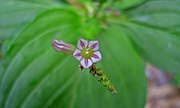en
names in breadcrumbs


Spigelia anthelmia, the West Indian pinkroot, wormbush, or wormgrass, is a species of flowering plant in the family Loganiaceae.[2] It is native to Mexico, Central America, the Caribbean, Florida, and northern South America through to Bolivia and Brazil, and it has been widely introduced to other tropical locales, including western and west-central Africa, India, Sri Lanka, Indonesia, Thailand, Peninsular Malaysia, Hainan, and the Bismarck Archipelago.[1] Highly poisonous, it is used as a vermifuge against intestinal worms.[2]
Spigelia anthelmia, the West Indian pinkroot, wormbush, or wormgrass, is a species of flowering plant in the family Loganiaceae. It is native to Mexico, Central America, the Caribbean, Florida, and northern South America through to Bolivia and Brazil, and it has been widely introduced to other tropical locales, including western and west-central Africa, India, Sri Lanka, Indonesia, Thailand, Peninsular Malaysia, Hainan, and the Bismarck Archipelago. Highly poisonous, it is used as a vermifuge against intestinal worms.

Inflorescence

Close-up of flower

Unripe fruit

An individual with narrower leaves
Spigelia anthelmia, conhecido popularmente como arapabaca, espigélia, erva-lombrigueira e lombrigueira, é uma planta da família das loganiáceas. É catártica e vermífuga. Contém o princípio ativo espigelina, que é venenoso, narcótico e mortal para o gado[1].
"Arapabaca" provém do tupi arapa'waca[1]. "Erva-lombrigueira" e "lombrigueira" são referências à sua propriedade anti-helmíntica.
Spigelia anthelmia, conhecido popularmente como arapabaca, espigélia, erva-lombrigueira e lombrigueira, é uma planta da família das loganiáceas. É catártica e vermífuga. Contém o princípio ativo espigelina, que é venenoso, narcótico e mortal para o gado.
Spigelia anthelmia là một loài thực vật có hoa trong họ Mã tiền. Loài này được L. miêu tả khoa học đầu tiên năm 1753.[1]
Spigelia anthelmia là một loài thực vật có hoa trong họ Mã tiền. Loài này được L. miêu tả khoa học đầu tiên năm 1753.